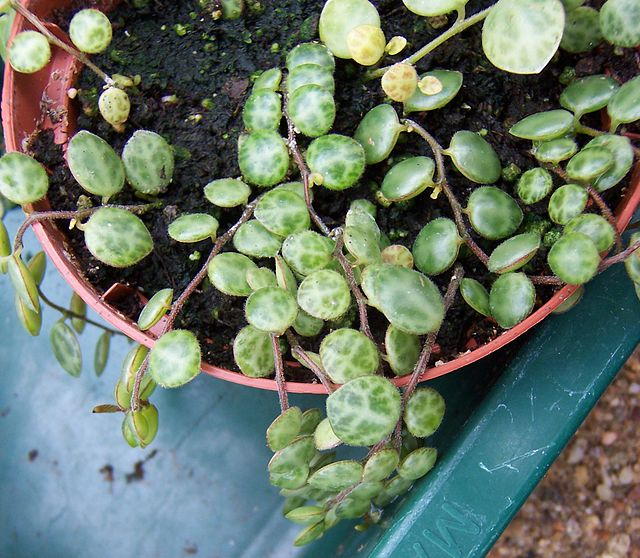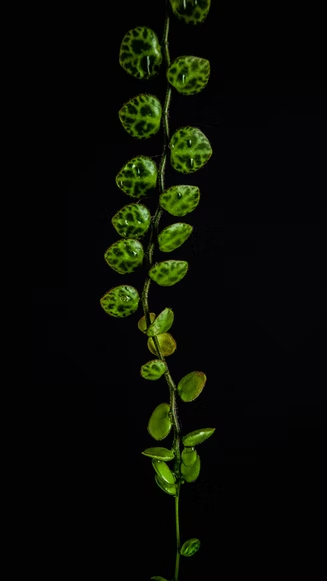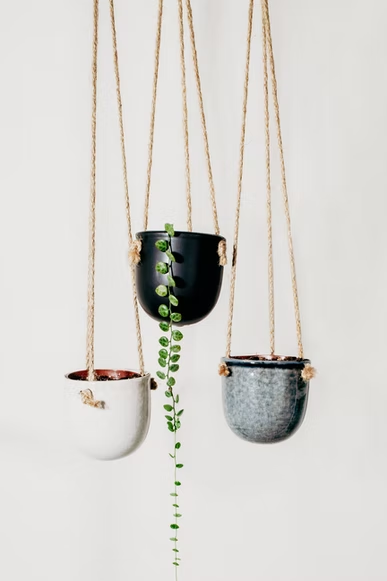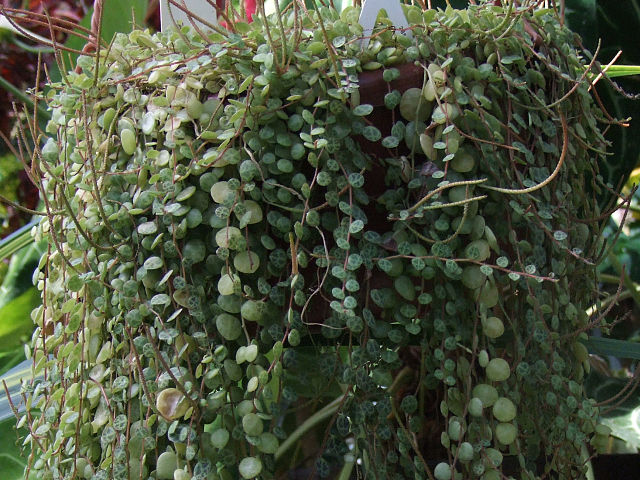Peperomia prostrata, popularly known as the String of Turtles, is a rare and easy-to-care houseplant with leaves that mimic turtle shells and gently hang from long vines. The String of Turtles are lovely vine, indoor plants endemic to the Brazilian jungles. They thrive best in hot weather but adapt well to ordinary living. Read now the String of Turtles a Peperomia Prostrata Guide for Beginners.

Credit: Wikimedia Commons (Salicyna)
A turtle string is an excellent option as a plant starter. Because of its attractiveness as a trailing vine, the plant is popular in fairy and container gardens. If you have limited room, it can also be planted in terrariums. For beginners, the string of turtles is an excellent indoor plant because it tolerates neglect and is somewhat considerate in unstable environmental conditions.
Profile
General Information
Peperomia prostrata is commonly called the “String of Turtles” because its light and dark green leaves have a pattern of white veins that resemble miniature turtle shells. The leaves of this little vining shrub are fleshy and round. This vine is a little succulent native to the Brazilian rainforests that thrive well in warm temperatures.
The Peperomia genus is usually found in the tropical regions of Central and South America. Therefore, you already have an idea that its ideal conditions include warm and humid environments with a not-so-harsh light condition and airy, breathable soil.
Etymology
The name “string of turtle” refers to the pattern of its light and dark green leaves, which have a pattern of white veins on the leaves, which resemble small turtle shells.
Peperomia is derived from the Greek words “peperi” (pepper) and “homoios” (resembling), which loosely translates as “pepper-resembling”. Prostrata, on the other hand, is derived from the Latin prosterno, which means “prostrate,” referring to the plant’s creeping growth habit.
Flowering

Credit: Wikimedia Commons (Krzysztof Ziarnek)
Flowers do grow on a String of Turtles, but they seldom blossom. These flowers have white blooms and are maroon on top. It has a design like tiny spikes. If a plant grows a new bloom, it will produce small cream flowers on long spikes with no scent. However, the flowers of Peperomias are pretty insignificant.
Season of Interest And Purchasing
Summer is the ideal growing season for String of Turtle reproduction and multiplication. The string of turtle plant is inexpensive and widely available at garden centers. As long as this plant is around, your surroundings will always have natural greenery. In addition, they will make your house a more pleasant place to live.
Growth
The String of Turtle leaves can measure up to 0.5 inches (1.3 cm) in width. Peperomia prostrata is a slow-growing plant that can reach a height of 12 inches when mature. The maximum width will vary based on the size of the pot. These plants are epiphytes in their native environment, which means they gain support from trees and other plants as they grow.
| String of Turtles Overview | |
|---|---|
| Scientific name | Peperomia prostrata |
| Common name/s | String of Turtles |
| Family | Piperaceae |
| Growth Habit | Succulent-like vine |
| Height and Spread | 12 inches when mature, leaves 0.5 inches in width |
| Classification based on life cycle | Perennial |
| Origin and Distribution | Originates from Central and South America |
| Climate Zone | Generally warmer climate |
| USDA Plant Hardiness Zone | USDA Zone 10 – 12 |
| Color | light and dark green leaves with a pattern of white veins that resemble miniature turtle shells |
Care Tips
Light Requirement
The String of Turtles is an excellent indoor houseplant since it does not require much light. During the day, at least moderately bright light. Bright indirect light, on the other hand, is ideal. Keep this plant out of direct sunlight for as long as possible. Too much direct sunlight might damage the lovely foliage of this houseplant. Consider these factors while deciding where to place this plant.
String of Turtles may be cultivated under fluorescent lights, or artificial grow lights. This increased light not only helps the plant develop but also broadens your home gardening possibilities.
Temperature Requirement
This plant would tolerate room temperature, but warm conditions are better for the turtle string. The String of Turtle plant requires an average temperature of 65 to 75 degrees Fahrenheit. Don’t let the temperature drop below 50 degrees Fahrenheit on this plant. At lower temperatures, the vines begin to wilt.
Avoid placing your Peperomia in drafty locations, such as an air conditioner or a central heating vent. Temperatures over 75°F are tolerable; however, severe heat may damage this plant.
Water Requirement
Watering requirements for the turtle string may vary based on humidity levels in your home and other factors. Many people water their plants two or three times each week. However, before watering again, allow the top inches of the soil layer to dry. You may test this by digging up to one inch into the soil.
The best way to water your plants is to soak them thoroughly and then let them dry to avoid root rot. Since it is a succulent plant, it can live with little irrigation because it stores water in its leaves. However, being a tropical plant, it prefers moisture and humidity.
Humidity Requirement
String of Turtles is a succulent and tropical plant native to Brazil’sBrazil’s moist rainforests. It likes to grow under high humidity. The humidity level needs at least 40 percent, but 50 percent or more is optimal.
Here are some ideas to maintain the humidity level of your plants:
- You may lay your plant on a pebble tray filled with water to guarantee optimal humidity levels.
- A humidifier also maintains the proper humidity level for your plant.
- Placing it in a bathroom or kitchen is the ideal location to deliver humidity to the plants in your home.
- Grouping your plants together is also a natural way to increase humidity.
Soil Requirement
Actually, the String of Turtles plants are quite easy to care for. However, an appropriate potting soil mix is required to maintain the plants healthy. To maintain the plant to become healthy and beautiful, you try to mimic the attributes of its natural habitat soil, which should be nutrient-rich and somewhat wet without becoming soggy or saturated. Since this plant may die quickly with root rot if it is experiencing a water log, a well-drained, moist soil mixture is required.
The most refined potting mix is made of organic soil, peat moss, and sphagnum moss, with added sand and perlite. Fertile potting soil will foster root growth, which will strengthen the vines. Soil with a pH between 5 and 7 is optimal in terms of acidity. You may change the pH of the soil by adjusting the proportion of soil components or introducing new ones.
The goal is to provide sufficient drainage and adequate nourishment to support the String of Turles root development and vine vigor.
Fertilizer Requirement
Feeding a string of turtles will help the plant keep its brilliant, shining vitality and ensure that the color and patterns of the leaves remain consistent throughout the growing season. Every 2 to 3 weeks, use a diluted succulent fertilizer. A slow-release fertilizer is excellent, and using fertilizer on a semi-regular basis helps keep the color and pattern of the leaves.
Reduce fertilizer use throughout the summer by applying it only once a month. A minimal amount is sufficient; too much fertilizer in the soil or water might cause the succulent-like leaves to droop. Water the soil before applying ready-to-pour fertilizers to avoid chemically scorching the roots. During the off-seasons, do not feed the plant from fall through winter.
Space Requirement
It is little in size and grows slowly; when fully grown, it will be 12 inches tall. If you have limited room, a string of turtles is an excellent option. This little vining plant would look great on a shelf, in a hanging basket, or on a desktop. Its adaptability makes it popular in fairy gardens, container gardens, and terrariums. It will undoubtedly spark conversation in any setting.
RELATED: Watermelon Peperomia: The Best Steps For Successful Propagation
Growing And Planting Tips

Credit: Wikimedia Commons (Dysmorodrepanis)
Propagation
Leaf and stem cuttings can be used to propagate a string of turtles quickly. The optimum time to plant a Peperomia prostrata is in the early spring, at the start of the growing season.
Using stem or leaf cuttings for propagation. First, get a clean set of scissors. Select a healthy stem or leaf, then cut a stem that has at least one node attached. Plant the cutting in a pot filled with fresh, well-drained, moist potting soil or in a jar of water.
Propagation in Water
Plant propagation in water is a simple way to increase your plants. After selecting a healthy stem, put your String of Turtle cutting in lukewarm water. Every few days, check the water level and refill it if it appears to be dirty. Wait patiently for roots to form. Then place the young plant in a new container and mist the plant regularly.
Propagation in Soil
Plants can be propagated by planting them directly on the soil surface. After selecting a healthy stem:
- Place the cutting on the soil.
- Leave the cuttings in the soil until roots develop.
- When the roots have formed, move the cutting to a pot or hanging basket.
- Care for it like any other indoor plant.
Propagation in Sphagnum Moss
Here’s another method for propagating your plants:
- Take some cuttings from a healthy plant.
- Place the cuttings on top of the sphagnum moss.
- Place a plastic bag over the pot containing the cuttings to increase humidity. Remove the plastic bag daily for a few hours to let in the fresh air. Wait patiently for the cutting to form roots.
- Place the cutting in new potting soil.
Pruning
Pruning will control any overgrowth when a string of turtles becomes wider. Pruning a struggling or leggy plant can also encourage new growth. Cut off undesired leaves and vines to direct the development of String of Turtles, as needed to keep this plant under control. To avoid infection or illness in the plant, use clean and sterilized scissors while pruning off damaged or dead leaves and stems.
Potting and Repotting

Credit: Unsplash (Lydia Mailloux)
In selecting the ideal pot, adequate drainage is the most crucial consideration. Make sure the bottom has drainage holes to remove excess moisture. If the plant’s roots are left in too much water, they may decay.
Replace the potting mix once a year, and only repot the plant if it has clearly outgrown its present container. In such a situation, use a pot that is one size larger than the existing one and has drainage. Remember, if at all feasible, repot in the spring or summer (the growth season). Generally, waiting around 2-3 years between repottings is the best way to go.
| String of Turtles Care | |
|---|---|
| Light | Filtered bright light, low to medium |
| Temperature | Intermediate to warm, 65-75 degrees Fahrenheit |
| Water | Once a week, increased in summer, decreased in winter |
| Soil | Fertile, well-draining mix |
| Fertilization | Regular household fertilizer, once a month |
| Space | Minimal space, vertical space needed |
| Propagation | Via stem propagation |
| Blooming | Rarely blooms, enough sunlight and maturity needed |
| Pruning | Occasional pruning |
| Potting | Regular potting mix or succulent mix, use of perlite, horticultural sand, peat moss, and sphagnum moss recommended |
Problems and Troubleshooting
Diseases
The immediate disease that causes peperomia plants to induce death is bacterial and fungal infections from root rot. To prevent these from harming your peperomia plants, make sure to avoid having them overwatered. Also, make sure only to water them if the top 2-3 inches of the potting soil is cracked and dry.
Pests
The most common pests that affect the Peperomias are mealybugs. Mealybugs suck the natural juices of plants, leaving them with insufficient nutrients and water to grow. They would look like tiny white critters that usually crawl under the leaves.
Also, you can observe if there is an infection if you see a cottony substance on your plant’s stems and leaves that is wool-like.
In order to eliminate them, you can utilize neem oil, one of the commercially available natural pesticides. Mix two teaspoons of neem oil to one teaspoon of liquid dishwashing soap with a liter of water that is lukewarm. Place in a spray bottle or any other containers, and apply over the peperomia leaves.
You may also use 70-percent isopropyl alcohol to apply to bugs and other plant pests directly.
Curling and Falling Leaves
Curling leaves are usually because of plant pests or, in many cases, nutrient deficiency. To avoid this, check for observable signs of pests like mealybugs and eliminate them when required. If there is a lack of nutrients, you can use a proper and high-quality fertilizer feeding to augment the watering.
For falling leaves, this is usually due to overwatering. Follow the watering tips above, and make sure to only water your plant if the potting mix is dry and cracky at the top.
Overwatering
Overwatering can cause root rot in strings of turtles. It can also look wilted or discolored, with soft, yellow, or mushy leaves. Overwatering may kill a String of Turtles. These succulents prefer soil that is only slightly moist.
In order to resolve this issue, take the plant’s pot off and look at the roots. If you see that they are rotting and brown, you should trim the dead roots out and repot the plant in fresh potting soil.
Underwatering
Underwatered String of Turtle is not a significant issue because it is a succulent plant that can survive with little watering. You’reYou’re better off underwatering than overwatering. If you notice that your vines have shriveled and dried up, immediately check your potting mix. Give your plants a good watering if they have dried out completely.
If your plant has been dried out for far too long, it will cause your plant to drop leaves and turn brown and crispy. If it is the sign, mist it immediately and let it absorb some water.
Nutrient Deficiency
Nutrient deficiency can result in slowed development, leaf browning, paler patterns, and other symptoms. Feed your plant to encourage root growth and more robust leaves to prevent this issue. However, this houseplant does not require much fertilizer, especially if you have a high-quality organic potting mix.
But some plant food will be helpful to them. Look for calcium-rich fertilizer since turtles, like other Peperomia, appear to benefit from calcium for more extensive, more robust leaves, and it is created to promote root growth in young plants.
Flowering Problem
This plant could not bloom mainly due to poor lighting, insufficient watering, and a lack of nutrients. However, Peperomia plants aren’t noted for their blooms, which are somewhat underwhelming, resembling a bushy spike or tail. Its flowers are small and have no fragrance at all. Most growers remove these little blooms, but the Peperomia prostrata flower can be kept if desired.
| String of Turtles Pests and Diseases | Common Pests/Diseases | Symptoms | Treatment and Prevention |
|---|---|---|
| Common diseases include crown rot, stem rot, root rot, leaf spot, fungal diseases, and Xanthomonas infection | Yellowish rimming around black or dark brown spots on leaves | Avoid overwatering. Keep soil dry. Avoid too high humidity. Proper ventilation is needed around the plant. Remove infected parts of fungal infections to avoid spreading. |
| Common pests include mealybugs, spider mites, aphids, and scales | Visible insects on the surface | Spray plants with warm, soapy water. If infestation is present, use insecticide or neem oil. Use diatomaceous earth. |
Problems with People and Animals
Toxicity
The plants in the genus Peperomia such as Peperomia String of Turtles plant do not contain toxins. Therefore, they are safe and are not poisonous to cats, dogs, and other pets.
Peperomia Plants Meaning and Symbolism
Peperomias are known to be an agent of luck in Brazil. Therefore, it is the perfect gift for someone who might be currently going through a tough time and needs some luck.
| Peperomia Hope Symbolism and Meaning | |
|---|---|
| General Meaning | Agent of luck |
| Symbolism | Resembling hope |
Landscaping and Gardening Ideas

Credit: Unsplash (Lydia Mailloux)
Companion Plants
While this plant looks great by itself, it would look even more marvelous when set next to the right companion plants. Fellow tropical plants go well with this plant. Particularly, it goes well with plants from the same family, such as Peperomia obtusifolia, Peperomia Quadrangularis, Peperomia metallica, and P. argyreia. It also goes well with Philodendrons, particularly Philodendron subhastatum, a climbing plant that adds a little flair to our peperomia plants.
More so, you may get some hanging plants with succulent-like qualities to go with your String of Turtles. since it needs similar care. Despite some of its characteristics resembling succulents, the String of Turtles is still a tropical plant. Pothos plants would be great companions. Those plants are well-known for their beauty, simplicity, and toughness. These plants would look fantastic next to a String of Turtles.
Landscaping Ideas
Turtle of String is a succulent that has fleshy-leaved plants with cascading vines or chains that are ideal for hanging gardens in pots or baskets, fairy gardens, container gardens, and terrariums.
This Peperomia is best planted indoors, with plenty of room for it to cascade. In an outdoor garden, it may grow in dappled shade beneath trees or bushes in tropical and subtropical locations. It’s also ideal for balconies or patios in hanging baskets.
| What to plant with | Other peperomias, Philodendrons, Pothos and other tropical plants |
| What NOT to plant with | Basically nothing |
Conclusion

Credit: Wikimedia Commons (Jerzy Opiola)
The String of Turtles was once thought to be uncommon due to the scarcity of succulent and tropical plants. It is a little vining plant with thick, round, dark green leaves with a lovely pattern of white veins that resemble miniature turtle shells.
Because of its dramatic look and attractive decorative foliage, a String of Turtles is an excellent houseplant addition. Consider exhibiting this indoor plant in your house in a hanging basket.
Frequently Asked Questions
How do you care for a String of Turtles Peperomia?
The Peperomia String of Turtles is a low-maintenance plant. Little care or attention is needed for this plant to thrive. However, make sure you give your plant the right environmental conditions such as light, watering, humidity, soil, etc.
Does Peperomia need sunlight?
Yes! Like all plants, Peperomias also need sunlight to photosynthesize or produce food for their nourishment and growth. Peperomias thrive in filtered bright light. However, make sure not to put your plant in direct sun to avoid burning the fleshy leaves.
Is String of Turtles toxic?
The plants in the genus Peperomia such as Peperomia String of Turtles plant do not contain toxins. Therefore, they are safe and are not poisonous to cats, dogs, and other pets.
Is Peperomia prostrata easy to care for?
Yes! Peperomia String of Turtles plants are low-maintenance plants that require little attention and care to thrive. They are suitable for beginners.
Can Peperomia grow in low light?
Peperomias can grow in a low-light environment. However, healthy, normal growth should not be expected. Low light conditions tend to produce plants with leggy stems, yellowish to white leaves, and broader leaf widths. These characteristics are often seen in plants grown in darker conditions.
Editor’s Recommendations
Root Maggots: How to Get Rid of Root Eating Insect Pest Naturally?
Identification and Control of Darkling Beetles by Natural and Chemical Ways
An All-In-One Guide to Small Brown Bugs | Fun Facts, Pictures and Identification Guide







